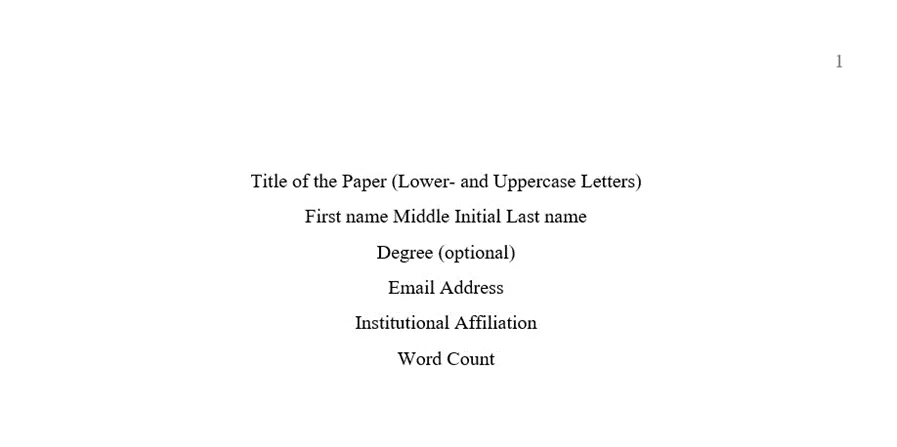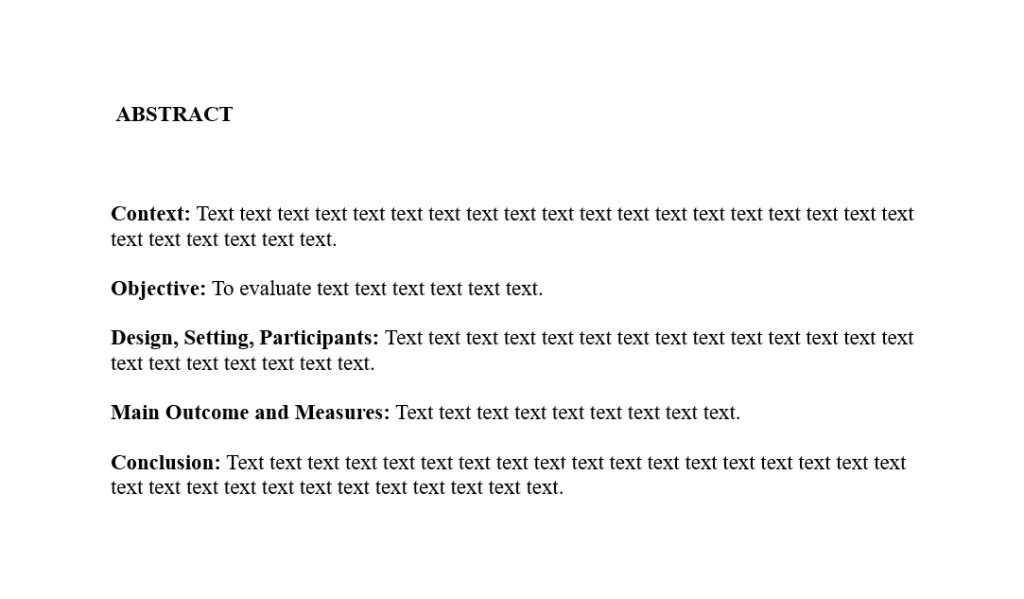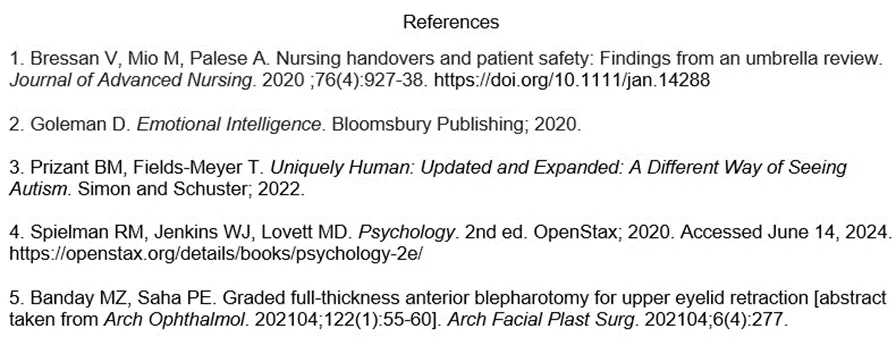AMA Citation Style Guide (11th ed.)
This piece of content has been developed by IvyPanda's editorial team.
No AI was involved in the creation process; only qualified experts contributed.
The information, facts, and sources presented in the text have been carefully checked and verified.
You are free to use it with proper referencing.
The AMA style is named after the American Medical Association. There is not much information about it in open access, so it can be tough even with our experience. With that said, once you gain access to some useful resources, it becomes much less complicated. As such, we have found some essential concepts with examples and compiled them for easy understanding. With this guide, you will be able to tackle the task of writing an AMA paper without much difficulty.
This guide is developed in line with the American Medical Associations AMA Manual of Style: A Guide for Authors and Editors. 11th ed. London, UK: Oxford University Press; 2020.
What is AMA?
The AMA style is primarily used in medicine, especially within the United States. It is numbered, which means that you have to assign a number to each separate reference entry and use these numbers to indicate which source is being cited in the text. As such, it is different from most other styles, though it borrows some ideas from Chicago and Oxford and is very close to Vancouver. Alternatively, it could be said that AMA refines the concept of in-text styles such as APA by reducing the amount of information in the citation to the bare minimum.
Why Cite Your Sources?
- When reading instructions, you may see an insistence on avoiding plagiarism and using the AMA style correctly. Here are some reasons why it exists and is so important to various educational and research organizations:
- Regardless of whether you are a student or a researcher, you cannot know the entirety of your field. Hence, you have to consult others’ works as well as your past ones to find information.
- The knowledge that you consult has to come from a reliable source, one that is trustworthy. Therefore, you are expected to favor scientific journals and books over websites, except for official ones authored by research organizations.
- No matter how reliable your source is it is worthless if the reader cannot find it. The accusation of referring to an article that does not exist is worse than that of using an untrustworthy website.
- Plagiarism is usually bad enough to warrant a harsh punishment that will at best entail you having to redo the assignment from scratch. You should avoid it for your own good whenever there is even a slight possibility of it.
General Principles of AMA Formatting
The manual of the AMA style is not very specific about formatting requirements, and most of the time, students should adhere to the instructions of their professors. Following are the recommendations of style if none are provided by the instructor.
- Double-spacing
- Margins – 1″ (2.54 cm)
- Font type: Times New Roman, Arial, or Calibri, 12 pt. AMA suggests two typefaces (a serif for body text and a sans serif for titles and subheadings) with appropriate use of styles, such as bold and italics for a scholarly publication.
- Every page should be numbered, starting with the title page. Page numbers are usually put in the upper left corner.
Papers written in AMA are required to have four sections:
- Title Page
- Abstract (structured or unstructured)
- Body (introduction, methods, results, discussion)
- References
AMA Title Page
AMA style does not have strict rules about formatting the title page; however, it should include several crucial features:
- Title
- Authors’ Name
- Degrees (above bachelors)
- Email address
- Institutional Affiliation
- Word Count (for text only, excluding title, abstract, references, tables, and figures)
Remember that every instructor may have their preferences as to organizing the title page.

AMA Abstract
- The abstract is written on a separate page.
- The word “ABSTRACT” is written in UPPER CASE, left justified, boldface, and is followed by a triple space.
- The text on the abstract page is NOT indented.
- The sections of the abstract are single-spaced with double spaces between them.
- Structured abstracts (abstracts using section heads) are used for original data, systematic reviews, and clinical reviews; they are usually limited to 300-350 words.
- Unstructured abstracts are used for all other manuscript types and are limited to 200 words.
- 3-10 keywords may be placed after the abstract.

AMA Headings
Level 1. Left-aligned, Bold, Uppercase and Lowercase. Double Space After.
Level 2. Centered, Italicized, Uppercase and Lowercase. Double Space After.
AMA Reference List
The reference list is written on a separate page with the title “References,” bold and left – justified, on the top of the page. Every source used in the body of the paper must appear in the reference list. Here are the requirements for the organization of this page:
- All the references are numbered and listed in the order they appear in the body of the paper.
- Reference numbers are indented 0.25″.
- The reference page in AMA is single-spaced with double spaces between entries.
- Regardless of the type of source referenced, a comma is never inserted between the last name and the first name of the author.
- If a piece of information and/or idea is borrowed from a specific page or range of pages, numbers of the said pages should be identified at the end of the corresponding reference.
- Authors’ last names are fully spelled. First name and middle name initials are put after the last name with no periods or commas between them.
1. Nnate DA, Nashwan AJ. Emotional intelligence and delivering bad news in professional nursing practice. Cureus. 2023;15(6):e40353. 10.7759/cureus.40353
1. Bressan V, Mio M, Palese A. Nursing handovers and patient safety: Findings from an umbrella review. Journal of Advanced Nursing. 2020;76(4):927-38. https://doi.org/10.1111/jan.14288
1. Bressan V, Mio M, Palese A. Nursing handovers and patient safety: Findings from an umbrella review. Journal of Advanced Nursing. 2020;76(4):927-938. https://doi.org/10.1111/jan.14288

AMA References
AMA Books Citation
When citing a book in AMA, a student is to provide authors’ last names as they appear on the cover of the book with initials. Commas are put between the authors’ names, and a period is put after the last author’s name. After that, you are to state the title of the book in italics with capitalization. After that, the publisher’s name is given. At the end of the entry, provide the year of the publication and page numbers, if specific pages are cited.
One author
Last Name Initials. Book Title: Subtitle. Publisher; Year.
1. Goleman D. Emotional Intelligence. Bloomsbury Publishing; 2020.
- Provide the name of the publisher after a colon, excluding Co. and Inc., which are not necessary for the identification of the publisher. However, do not omit the words Books and Press.
- Use a semicolon before providing the year of the publication.
- If the date of publication cannot be located, use the words “date unknown” in place of the date.
Two to six authors
Last Name Initials, Last Name Initials, Last Name Initials, Last Name Initials, Last Name Initials, Last Name Initials. Book Title: Subtitle. Publisher; Year.
1. Prizant BM, Fields-Meyer T. Uniquely Human: Updated and Expanded: A Different Way of Seeing Autism. Simon and Schuster; 2022.
More than seven authors
Provide last names and initials for the first three authors of the work and add “et al.” after the third author.
Last Name Initials, Last Name Initials, Last Name Initials, et al. Book Title: Subtitle. Publisher; Year.
1. Mehrer M, Flatman J, Flemming N, et al. GIS and Archaeological Site Location Modeling. Taylor & Francis; 2021.
Corporate/organization author
Organization Name. Book Title: Subtitle. Publisher; Year.
1. World Health Organization.WHO Report on Global Health Worker Mobility. World Health Organization; 2023.
Unknown author
Book Title: Subtitle. Publisher; Year.
1. Alluvial Archaeology in Europe. Routledge; 2021.
Edited book, no author
In an edited book with no author, move the editor name to the author position and follow it with the abbreviation ed. for one editor or eds. for multiple editors.
Last Name Initials, ed. Book Title: Subtitle. Publisher; Year.
1. Snow N, Cull NJ, eds. Routledge Handbook of Public Diplomacy. Routledge; 2020.
Edited book with an author/authors
When citing an edited source, place the editor’s last name and initials immediately after the book’s title, followed by the abbreviation ed. for one editor or eds. for multiple editors after a comma.
Author’s Last Name Initials. Book Title: Subtitle. Editor’s last Name Initials, ed. Publisher; Year.
1. Calfee M. Strategic Issues Management: A Systems and Human Resources Approach. Emory KV, ed. Jossey-Bass; 2021.
An author with a translator
When referencing a translated book, place the name(s) of the translator(s) immediately after the book’s title, add the abbreviation trans.
Author’s Last Name Initials. Book Title: Subtitle. Last Name Initials, trans. City of publication, Country/State code: Publisher; Year.
1. Leary P. Metaphors in the History of Psychology. Burt AW, Kernberg FL, trans. Chicago, IL: University of Chicago Press; 2024.
Different editions
Include information about the edition immediately after the title without any italics or parentheses. Never indicate the first edition. Abbreviate “New revised edition” as “New rev ed,” “Revised edition” as “Rev ed,” “American edition” as “American ed,” and “British edition” as “British ed.”
Last Name Initials. Book Title: Subtitle. # ed. Publisher; Year.
1. LaDou J, Harrison R. Current Diagnosis & Treatment Occupational & Environmental Medicine. 6th ed. McGraw Hill Professional; 2021.
Chapter in an edited book
When citing a chapter of an edited book, put the authors of the chapter in the author’s position and cite the name of the chapter without italics or capitalization. Enter the word In followed by a colon and state the editors’ names in general format followed by abbreviation ed/s. Please pay special attention to page numbers as they are required for this type of source.
Author’s Last Name Initials. Chapter title. In Last Name Initials, ed. Book Title: Subtitle. Publisher; Year:pages.
1. Noone D, Langlois V. Laboratory evaluation of renal disease in childhood. In: Schaefer F, Greenbaum LA, eds. Pediatric Kidney Disease. 3rd ed. Springer; 2023:37-68.
Multivolume work
Give volume number preceded by Vol / Vols with no period. End with a period.
Last Name Initials. Book Title: Subtitle. Vols x–x. Publisher; Year.
1. Agarwal AM. Objective Mathematics for Engineering Entrances. Vol 1. Arihant Publications; 2022.
Encyclopedia/dictionary
Last Name Initials, ed. Book Title: Subtitle. Publisher; Year.
1. Pickren WE, ed. The Oxford Encyclopedia of the History of Modern Psychology. Oxford University Press; 2022.
- If a specific entry is used, it is cited as a book chapter with page numbers being an essential part of the citation.
- Remember to put the entry’s author in the first position.
- If the entry’s author is unknown, start with the name of the entry.
1. Wallace RJ Jr, Griffith DE. Antimycobacterial agents. In: Kasper DL, Fauci AS, Longo DL, Braunwald E, Hauser SL, Jameson JL, eds. Harrison’s Principles of Internal Medicine. 16th ed. 2020:946.
Online book
Online books are cited as printed books with the addition of URL and access date.
Last Name Initials. Book Title: Subtitle. Publisher; Year. Accessed Month Date, Year. URL.
1. Spielman RM, Jenkins WJ, Lovett MD. Psychology. 2nd ed. OpenStax; 2020. Accessed June 14, 2024. https://openstax.org/details/books/psychology-2e/
Online book (no date)
When citing electronic books with no available data about the publication date, state the name of the website and provide the access date and URL.
Last Name Initials. Book Title: Subtitle. E-Library Name. URL. Accessed Month Date, Year.
1. Kopf R. Low Blood Pressure—Hypotension Treated with Homeopathy and Schuessler Salts (Homeopathic Cell Salts). Booktrix. Accessed June 14, 2024. https://www.bookrix.com/_ebook-robert-kopf-low-blood-pressure-hypotension-treated-with-homeopathy-and-schuessler-salts-homeopathic/.
Chapter in an online book or web document
Last Name Initials. Chapter title. In Last Name Initials, ed. Book Title: Subtitle. Publisher; Year. Accessed Month Date, Year. URL.
1. National Research Center. How teachers teach: specific methods. In: National Research Center. Science Teaching Reconsidered: A Handbook. National Academy Press; 2022. Accessed June 15, 2024. https://www.nap.edu/read/5287/chapter/3.
Online encyclopedia/dictionary
When citing an online encyclopedia or a dictionary, include the name of the website after the title of the work.
Entry title. In Last Name Initials, ed. Book Title: Subtitle. Website. Accessed Month Date, Year. URL.
1. Kashmiri Shaiva philosophy. In: Fieser J, Dowden B, eds. Internet Encyclopedia of Philosophy. IEP. Accessed June 15, 2024. http://www.iep.utm.edu/kashmiri/.
AMA Articles Citation
Scholarly journal article
Last Name Initials. Article title. Periodical Abbreviation. Year;volume(issue):pages.
1. Thyssen JP, Schuttelaar ML, Alfonso JH, et al. Guidelines for diagnosis, prevention, and treatment of hand eczema. Contact Dermatitis. 2022;86(5):357-378. doi.org/10.1111/cod.14035
Magazine article
Last Name Initials. Article title. Magazine Title. Month Date, Year:pages.
1. Kelley JP. Lizards, legends & laughs: how GEICO evolved the way they entertain. Forbes Magazine. April 11, 2024:1–3.
Newspaper article
Last Name Initials. Article title. Newspaper Title. Month Date, Year:pages.
1. Tharoor I. Away from war, Ukraine’s soccer stars ready for battle. Washington Post. June 17, 2024.
Letter to the editor in a magazine/newspaper
Last Name Initials. Article title [Letter to the editor]. Newspaper/Magazine Title. Month Date, Year:pages.
1. Jenkins J. It’s time for the President to take responsibility for his words and actions [Letter to the editor]. The Washington Post. January 30, 2022;233.
Review article
There are no special rules for citing review articles in AMA citation style. Therefore, apply the general format for citing articles in such cases.
Last Name Initials. Article title. Periodical Abbreviation. Year;volume(issue):pages.
1. Kumar R, Saha P, Kumar Y, et al. A review on diabetes mellitus: type1 & type2. World J of Pharmacy and Pharm Sci. 2020;9(10):838-850. doi:10.20959/wjpps202010-17336
Abstract
You may use the abstract only if the full article is not available. If you are citing the abstract in AMA as part of the full article, cite the full article without any additions. Otherwise, add information about the abstract in square brackets including the number of the abstract or the citation of the journal it originally came from.
Last Name Initials. Article title [abstract taken from Periodical Abbreviation. Year;volume(issue):pages]. Periodical Abbreviation. Year;volume(issue):pages.
1. Banday MZ, Saha P. Graded full-thickness anterior blepharotomy for upper eyelid retraction [abstract taken from Arch Ophthalmol. 2021;122(1):55-60]. Arch Facial Plast Surg. 2021;6(4):277.
Article in an online journal (DOI)
According to the 11th edition of the AMA Style Guide, it is advisable to provide a DOI of an article if it is available. The ability to easily and accurately copy and paste DOIs is important, which is why a period or other punctuation should not be included after the DOI since the risk of the punctuation becoming a part of the DOI itself is too great and would create problems with linking. Meanwhile, online linking is one of the key reasons to have a DOI in the first place. There is only one accepted format of DOI is: doi:0000000/000000000000
Last Name Initials. Article title. Periodical Abbreviation. Year;volume(issue):pages. doi:
1. Banday MZ, Sameer AS, Nissar S. Pathophysiology of diabetes: an overview. Avicenna J of Med. 2020;10(04):174-188. doi.org/10.4103/ajm.ajm_53_20
Article in an online journal (without DOI)
When citing online journals with no DOI, students are required to mention the URL, publication or last update date, and the access date.
Last Name Initials. Article title. Periodical Abbreviation. Year;volume(issue):pages. URL. Published Month Date, Year. Accessed Month Date, Year.
1. Cole JB, Florez JC. Genetics of diabetes mellitus and diabetes complications. Nature Rev Nephrol. 2020;16:377-390. https://www.nature.com/articles/s41581-020-0278-5. Published May 12, 2020. Accessed June 17, 2024.
Online newspaper/magazine article
Last Name Initials. Article title. Newspaper/Magazine Title. Month Date, Year. Accessed Month Date, Year. URL.
1. Landler M, Erlanger S. G7 leaders, expanding the circle, shift focus to migration and the South. The New York Times. June 14, 2024. Accessed June 17, 2024. https://www.nytimes.com/2024/06/14/world/europe/g7-summit-ai-china-india.html.
(Online) book review
There are no special rules for citing online book reviews in AMA citation style. Therefore, you are to use the general format for citing articles.
Last Name Initials. Article title. Periodical Abbreviation. Year;volume(issue):pages. URL. Published Month Date, Year. (for online reviews: Accessed Month Date, Year)
1. Delibaş A. The new map: energy, climate, and the clash of nations Daniel Yergin. Insight Turkey. 2022;24(3):259-261. https://www.jstor.org/stable/48733392
- Alternatively, provide a DOI instead of a link.
- If the publication date is unknown, avoid the section.
AMA Website Citations
Page from website
Last Name Initials. Page title. Website Name. Month Date, Year. Accessed Month Date, Year. URL.
1. Meadley HJ. Vaccines & immunizations. CDC. November 16, 2023. Accessed June 16, 2024. https://www.cdc.gov/vaccines/index.html
Page from website with unknown author
Page title. Website Name. Published Month Date, Year. Accessed Month Date, Year. URL.
1. Best in travel 2024. LonelyPlanet. 2024. Accessed June 17, 2024. https://www.lonelyplanet.com/best-in-travel
Page from website. Organization
When citing a web page from an organization’s website, put the organization’s name after the title of the webpage instead of the name of the website.
Page title. Organization Name. Month Date, Year. Accessed Month Date, Year. URL.
1. Meningococcal disease in Saudi Arabia – vaccine requirements for travel during the Hajj and Umrah pilgrimages. Centers for Disease Control and Prevention. May 20, 2024. Accessed June 17, 2024. https://wwwnc.cdc.gov/travel/notices/level1/hajj-umrah-saudi-arabia
Blog
AMA suggests using the general format for websites but adds italics and the source type indicator.
Last Name Initials. Blog post title. Blog Name blog. Month Date, Year. Accessed Month Date, Year. URL.
1. Campbell KP. Updated guidance on reporting race and ethnicity: let’s start with the why. AMA Style Insider blog. November 15, 2021. Accessed June 17, 2024. https://amastyleinsider.com/2021/11/15/updated-guidance-on-reporting-race-and-ethnicity-lets-start-with-the-why/
Video or film
AMA citation style allows putting a director’s or a producer’s name in the author’s position. Make sure to put a medium in square brackets.
Director’s or Producer’s Last Name Initials. Film/Video Title. Format Medium. Production or distribution company; Year. URL (if applicable)
1. Ohayon S. Haute couture. DVD. Orange Studio; 2021.
Podcast/YouTube
When citing a video, provide the author only if you are sure that the person created the video. Do not list the person posting the video online as the author. If you are unsure, treat the citation as having no author.
Username YouTube page. Film/Video Title. Month Date, Year. Accessed Month Date, Year. URL
1. GreenTree Production YouTube page. HOPE (2020). August 6, 2022. Accessed June 17, 2024. https://www.youtube.com/watch?v=1P3ZgLOy-w8&list=RD1P3ZgLOy-w8&start_radio=1&ab_channel=GreenTreeProduction
AMA Dissertation and Thesis Citation
Dissertation/thesis
Titles of theses and dissertations should be given in italics. References to theses should include the name of the university (or other institution) and year of completion of the thesis. If the thesis has been published, it should be treated as any other book reference.
Last Name Initials. Title of Work. Dissertation or master’s thesis. Institution; Year.
If the thesis is available online, add the access date and the URL.
Last Name Initials. Title of Work. Dissertation or master’s thesis. Institution; Year. Accessed Month Date, Year. URL
1. Xing Q, Adu OF. Improving guidance for type 1 diabetes: factors connected to guidance for children. Master’s thesis. Lapland University of Applied Sciences; 2020.
2. Mahmoud, FMZK. Drug utilisation patterns and factors influencing prescribing choice of antidiabetic drugs among patients with type 2 diabetes mellitus in Scotland, 2010-2020: a population-based, multi-study project. Dissertation. University of Strathclyde; 2023. Accessed June 17, 2024. https://stax.strath.ac.uk/concern/theses/xk81jk94m
AMA Lecture Citation
Online lecture notes/presentation slides
When citing lectures in AMA, put the professor’s name in the author’s position. Never use italics in the title of the lectures.
Last Name Initials. Title of lecture [Class lectures]. Institution; Year. Published Month Date, Year. Accessed Month Date, Year. URL
1. Arnold D. Functional analysis [Class lectures]. Stanford University; 2022. Accessed June 17, 2024. http://www-users.math.umn.edu/~arnold/502.s97/functional.pdf.
AMA style allows putting an author’s or a presenter’s name in the author position when citing presentations.
Last Name Initials. Title of lecture [Class lectures]. Institution; Year. Published Month Date, Year. Accessed Month Date, Year. URL
1. Pomije B. Online shopping. Presented at: Class lecture, January 9, 2020. Accessed January 21, 2024. http://www.slideshare.net/pobr0702/online-shopping-presentation-10492184.
- Most lecturers would rather you did not cite the lecture notes but found the relevant information in books, journals, or other such resources. Only use lecture notes if you cannot find the information elsewhere.
- Only include the full link to the document if a) you have tested the link and it will work several days after you originally accessed the document, and b) you are confident the person reading your work can access the site. Otherwise, simply include the URL.
AMA Government Documents Citation
Government publication
Government reports are treated the same as an electronic journal and book reference. Apply the same rules as journal style for articles and book style for monographs. Include the published and updated date (if available) as well as accessed date.
Organization Name. Publication Title. Publication Number. Publisher. Month Date, Year.
1. Office on Women’s Health. Statistics: autoimmune diseases. Updated February 22, 2021. Accessed January 11, 2024. https://www.womenshealth.gov/a-z-topics/autoimmune-diseases
AMA Personal Communication Citation
Personal communication and unpublished material are not included in the AMA reference list. However, parenthetical in-text citation is a must.
(K. Dawson, personal communication, April, 2023).
In a conversation with Dr. Smith (October 2023)…
As described in recent literature (H. E. Marman, MD, unpublished data, January 2023)…
AMA In-Text Citations
AMA citations style uses superscripts to give credit to the initial author of an idea or information that the student has borrowed. The superscript number should appear to the right of periods, commas, and quotation marks and to the left of colons and semicolons. Give credit to all the sources that were used in a sentence by using unique superscript numbers.
The engineer announced that the house was built on solid ground1; however, the observers doubted that.
“The role of obesity on the development of allergic rhinitis is not well defined, whereas allergic rhinitis may have an impact on obesity.”1
The report states:
Allergic diseases, such as asthma and allergic rhinitis, are common chronic inflammatory diseases of the airways. Obesity is an increasingly common pediatric disease and is a risk factor for the development of asthma in that obese patients with asthma tend to have more severe asthma that does not respond well to standard asthma therapy. On the contrary, children with asthma maybe at a high risk of obesity, suggesting that the relationship of asthma and obesity seems to be interrelated.1
The engineer announced that the house was built on solid ground.1(14)
Figures and Tables in AMA
Figures
The AMA style does not provide specific guidelines on table formatting, especially because different medical journals that use it have varying standards. The only specific stipulation is that you should use single spacing for everything except for the main text, such as additional objects. To separate it from neighboring passages, you should use double spacing on the edges. As such, you should use formatting that you prefer or follow the example provided in this guide (see figure 1). Generally, you should use numerical references like that of usual in-text citations.

Figure 1. Glass World1.
You should note that the AMA style generally frowns on overusing tables and figures. They are intended to present complex data and relationships in a more accessible manner, so you should only use them when doing so is absolutely necessary. Also, do not overcomplicate the presentation of data as it will be adjusted to reduce any clutter in the editing process regardless. When using a table or figure you have taken from a print source, be sure to identify the paper or book, as well as the location of the object, clearly. Online sources are easier to cite because you can provide a direct link to the item most the time, though they may not be as credible.
Reference List
1. Glass World. EnvironmentalScience.org. https://www.environmentalscience.org/wp-content/uploads/2016/09/NEPA-CEQA-640×425.jpeg. Accessed June 19, 2024.